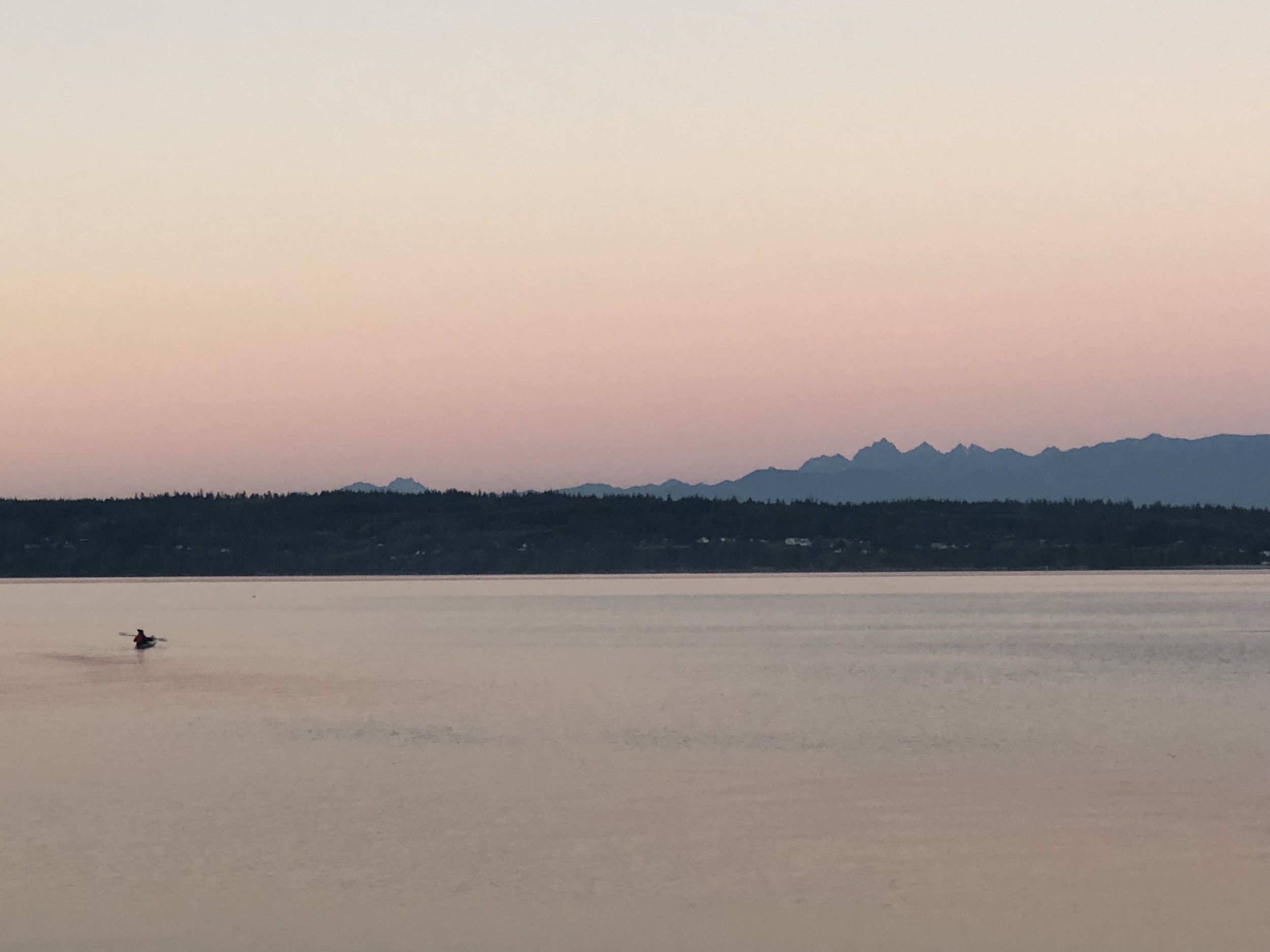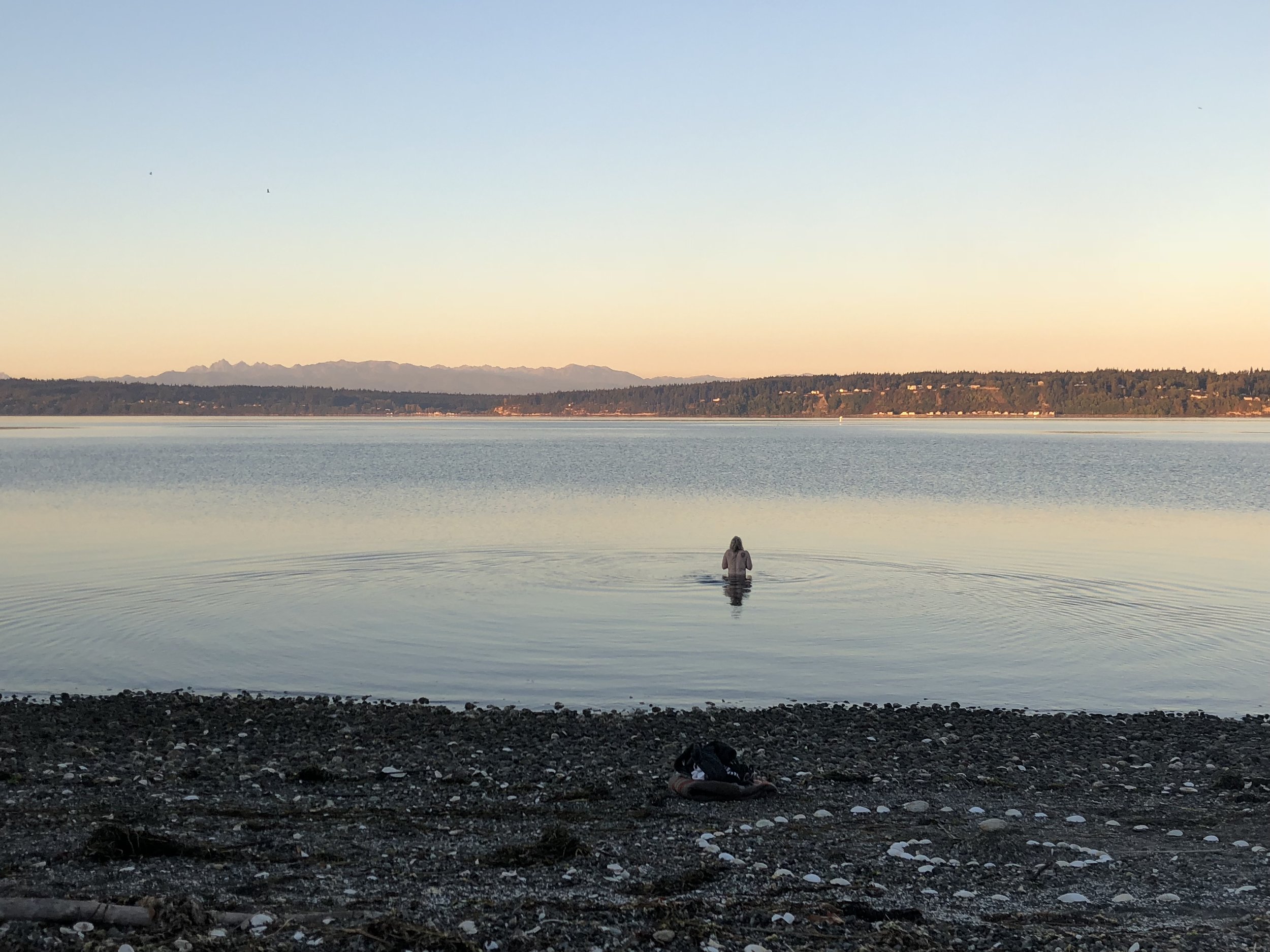The Song of the Sea: Reflections on a Selke Soul-Skin Rewilding Retreat
The sun was just warming the sky with the first blush of pink and purple; the sounds of daybreak resonated over the threshold of land and sea. While I was starting the fire for a beach front morning matins, I heard the song—sonorous notes rippling over the waves coming from a lone kayak put out to sea. And then, the bobbing heads of seals emerged through the waves, encircling the modern coracle, receiving the morning melody that called to them and affirming the enchantment of the moment. It was as if the myths were awakening, or more likely, that we were awakening to the myths. For as our gathered group told and retold an ancient tale of shape-shifting seals, attunement began to occur—a tuning of the senses to the song of the more-than-human world happening all around us.
Mythtelling assumes that the stories already exist in nature, waiting to be overheard by humans who will listen for them…a myth is the power of a place, speaking. -Sean Kane
The collective energies of the Autumn (season), West (cardinal direction), and Water (element) land themselves in the work of the watersheds and seas within the coordinates of the Rewilding Wheel. In the westward quadrant of this wheel we gravitate towards bodies of water, an elemental way of binding back to ourselves. In this place we fully explore our becoming as water reflects the nature of the soul. It symbolizes the principle of “as above, so below, as within, so without.” Spiritual traditions teach that everything in the outer world is a reflection of our inner world, which provides a sobering invitation when looking at how our water sources are being mistreated. However, our spiritual growth around the wheel provides us with a sense of vision and imagination now that we are in our westward posture. We can draw deeply upon Source, as if from a deep well, and imagine how our waters should be treated, honored, and respected. Woman are particularly empowered in this quadrant as our bodies are profoundly tied to water literally and metaphorically.
As water flows from the mountaintops, through the forests and fields, and ultimately to the sea, this becomes a bioregional expression of fullness, of completion. Here the water shows us what it is meant to become through its appearance as Winter’s snow, Spring’s rain and snow-melt rivers, Summer’s wellsprings, and then the final meeting with the oceanic body. This journey bears echoes of our own psycho-spiritual formation as we too make our own journey through the seasons—bringing us West towards our own fullness and mellowed maturity. This is an invitation into an enchanted way of living—we see a reflection of ourselves within our bioregion as we re-learn to speak the language of seasons, of the sea, and even of the Selkie.
These interconnected themes and energies inspired the Autumn Rewilding Retreat, a weekend away on the Salish Sea where the Celtic myth of the Selkie was explored as way of reclaiming aspects of ourselves that were lost or dismembered along the way, and rediscovering core aspects of our True Self that are critical to an authentic way of belonging within our world. This shape-shifting story is one that honors the process that one goes through to become and belong fully to themselves as well as to the wild and sacred world. And so this retreat engaged this story as a way to recovering the “skin we are meant to be in.”
The particular location of this retreat provided a variety of sacred spaces. We created a “Sea Sanctuary” where individuals were invited to engage the collective energies of the Rewilding Wheel through prayers and practices that clarified how these elemental aspects of life itself are connected to our human lives as well. Prayer sticks created from Hedgewood herbs and plants were gifts that linked the elements together—earth, fire, air and water were all in tandem as praying participants were invited to light the prayer stick while standing in the sea. This is a powerful tradition of speaking your prayerful intentions into the water. The practice of praying immersed in water was one of the more extreme ascetic traits popular amongst Celtic saints. It is said that even Columba on the Isle of Iona would wade deep into the sea to pray for hours upon a time. Consider how water conducts energy and is very transformable. It changes depending on what the offering or intention is. In the Lakota way of prayer and worldview, Mni Wiconi means water is life and water is alive. Water has consciousness. Water has personhood. Water is eternal as our planet is a closed planet. This element of water has always been. Praying in the water intensified your prayer. Literally water evaporates so that water that has just been transformed by your words, your intentions, your energy, travels into clouds, which then travel the world. Your prayers can come down in the form of rain on the other side of the world. So your prayer and your intention you are sending may come down as snow in the Andes, or rain in the Amazon. You are sharing the consciousness of your prayer with the consciousness of the planet through praying within the water.
“May what I do flow from me like a river,
no forcing and no holding back,
the way it is with children.
Then in these swelling and ebbing currents,
these deepening tides moving out, returning,
I will sing you as no one ever has, streaming through
widening channels
into the open sea.”
—Rainer Maria Rilke
Weaving is another form of prayerful intention that shows up in myths from around the world; the weaver is often associated with the feminine and crone and shows up as a symbol of the Present who holds the threads of Past and Future within her omniscient knowing. With this mythopoetic understanding in mind, we created a sea-loom where retreat participants could co-weave a soul-skin, an expression of hopes, desires, and prayers for the reclamation of their meant-for-selves. The woven work took the whole weekend to create and then this “soul-skin” was sent out to sea on the last day, representing our prayers for reclaiming our re-woven self.
When one begins to recover the dismembered or buried feminine, one taps into a wellspring of creativity. This creativity is often conveyed archetypally through foundational creating often through the act of weaving. In Native American traditions you can find stories of Grandmother Spider who weaves creation and stories into being. In the Greek tradition it is Gaia who creates the cosmos. In Celtic tales you have the Old Woman of the World who spins and weaves the continuity of time. Through participating in this ancient practice, there was a sense that we were not only weaving ourselves back together, but we were weaving ourselves back into our very place. Much of our sense of dismemberment and soul-loss is a result of not being deeply rooted and connected to the spirit of our place.
Rewilding Retreats aim to provide nourishing foods that reflect the energies of the seasons as well as provide a pallet that reminds us of where we are, the foods that actually help form and shape our bodies through their biochemistry. This retreat was no different with the meals offering seasonal sustenance through apples, nuts, squash blossoms, rosemary and elderberry syrups. Most fun was the sea inspired smoothie bowls that were created every morning with the use of an extract of spirulina, a fresh-water algae that carries water notes and an amazing dose of B12.
In many respects, eating well is an invitation into dwelling well. We can be in a place and not know where we are or how to be there. We can also come to forsake or degrade places because we do not appreciate how vital they in fact are. Growing and eating the unique foods found in specific bioregions enables us to inhabit the places of our lives with a more detailed understanding and empathy. Ecotheologian Norman Wirzba states, “Food creates a profound connection to a place. To fail to know places in detail, and the wisdom that has collectively been learned there, is to lose the possibility of detailed understanding. Failing to understand, human action will grow to be out of step with, and perhaps even destructively contrary to, the processes of life that feed personal life”(1). The food served at these retreats hope to create this sense of reciprocity and sacred balance that is critical for all life to flourish in our bioregion.
The elements that were aligned for this Rewilding Retreat weekend created a portal for the Sacred to be seen and experienced in profound and powerful ways. There was a sense of sacred enchantment present as we played and practiced at the sea’s threshold. While we were praying matins one morning, a group of seals came almost right up to the shore, staying at the water’s edge throughout our liturgy! Mythologist, psychotherapist, and writer Sharon Blackie says this of how local knowing and detailed understanding creates connections within the seen and unseen world: “Enchanted living embraces a wider world, and acknowledges the value of respect and interdependence between richly different cultures—but it does so from the perspective of a deep grounding in its own locality, and in the unique bioregion which supports it” (2). This then is the process of rewilding—the practice of awareness and reconnection to the cultures (both human and more-than-human), the niches, the ecosystems, which we occupy, and re-membering ourselves to the sacred stories these places speak. This is the great work of reweaving ourselves back into our places, belonging once again not only to our True Self, but within the wild world that has given us rise.
Selkie Drawing by retreat participant Sarah Bylsma (2018)
“I have a feeling that my boat
has struck, down there in the depths,
against a great thing.
And nothing
happens! Nothing…Silence…Waves…
—Nothing happens? Or has everything happened,
and are we standing now, quietly, in the new life?”
—Juan Ramón Jiménez
(1) Norman Wirzba, Food & Faith: A Theology of Eating (New York: Cambridge University Press, 2011), 40.
(2) Sharon Blackie, The Enchanted Life: Unlocking the Magic in Everyday Living (Tewkesbury UK: September Publishing, 2018), 214.










